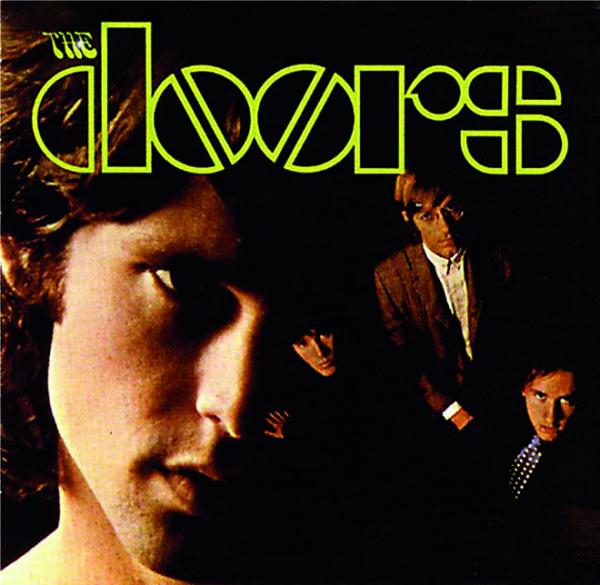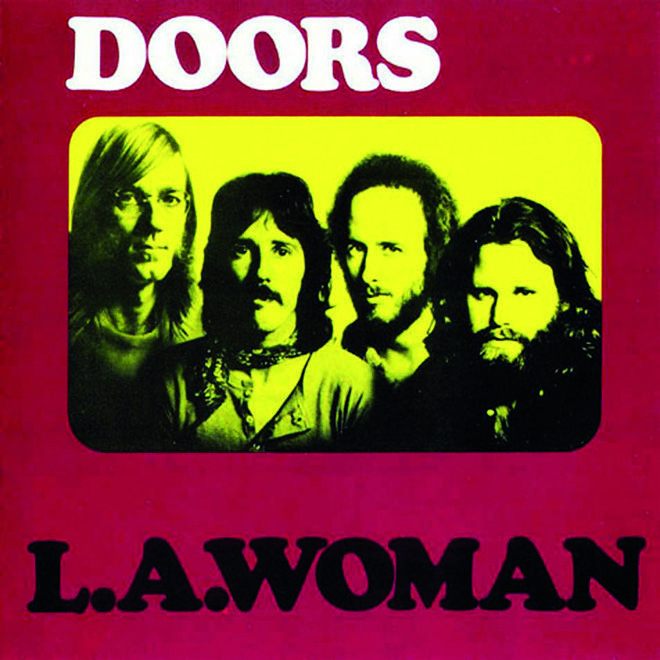Music Legends: The Doors

It is now 50 years since The Doors released their startling debut LP, which unleashed the audacious and unsettling poetic visions of Jim Morrison on an unsuspecting world – and a flurry of Doors-related activity is underway to mark this rather auspicious anniversary.
The group’s self-titled debut album is being reissued this month in a new three-disc deluxe edition, featuring remastered mono and stereo mixes and previously unheard live versions of eight of the original album’s 11 songs, recorded just as the band was on the verge of superstardom (see p100). It follows closely on the heels of the release of London Fog 1966, an historic album of recently unearthed live recordings from a gig in a club on Sunset Strip shortly before the group signed its first recording contract.
That the music of the Doors continues to exert such a profound and far-reaching influence on our collective psyche so long after the event is in stark contrast to the group’s active lifespan, which – even by the ephemeral standards of rock and roll – was extraordinarily brief and fleeting.
Today bands like Radiohead and U2 take a leisurely half a decade or more between albums. Yet the entire recording career of The Doors classic lineup lasted for just four years between 1967 and 1971, during which time they recorded and released six studio albums and the in-concert set Absolutely Live.
Yet in the short time, starting with their remarkable 1967 debut, which included Light My Fire, and concluded with their swansong LA Woman, released a few weeks before Morrison’s death in 1971, The Doors made some of the most potent, enduring and leftfield pop music ever recorded and forged a reputation that would forever guarantee them a place in the annals of rock history.
Strange days
At a time when most of their contemporaries were wearing flowers in their hair and warbling about peace and love, The Doors explored the darker side of the human condition and sang strange, apocalyptic songs about sex and death.
On one level, their music was undoubtedly of its time, inspired by the hedonism, energy and experimentation of the late sixties, an era when old certainties were being challenged and anything seemed possible. Yet the music of The Doors was not confined or defined by those times – which is why it has remained impervious to changes in fashion, exercising an endless fascination for successive generations of musicians and fans not even born when Morrison’s mojo was first rising.
“I can’t really think of anyone who has done anything like it since,” The Doors’ organist Ray Manzarek remarked in his final interview before his death in 2013. Listening to the likes of The End and Light My Fire from the group’s debut album half a century on, it is impossible to disagree. The Doors’ music has not only stood the test of time, but the group continues to inhabit a category in the rock pantheon that is all its own. Many have tried to copy them. Yet nobody has really come even close.
Much of that uniqueness was down to Morrison’s shamanic presence and the vivid imagery of his lyrics. “Jim as a spoken poet was not that good on his own,” Manzarek once observed. “He needed the music behind him. He felt a security and a sense of abandon when the music existed around him”.
The other side of The Doors’ partnership was that the music of Manzarek, guitarist Robbie Krieger and drummer John Densmore lost much of its potency when stripped of Morrison’s dramatic songwriting and charismatic persona. This became cruelly evident when, after the singer’s death, the three remaining members of the group signed a five-record deal to continue without him. After two insipid albums on which Manzarek and Krieger shared the vocals and which swiftly ended up in the cut-out bins, the contract was cancelled by mutual consent.
One of the band’s showpiece songs was titled When The Music’s Over – and for The Doors it effectively came to an end on the fateful day of 3 July, 1971 when Morrison died from heart failure in his bath in his apartment in Paris. He was just 27– a number that has become notorious in rock folklore, for with gruesome coincidence it was the same age at which Brian Jones, Janis Joplin and Jimi Hendrix also died within the space of two years. Later, Kurt Cobain and Amy Winehouse were among other tragically wasted talents to join the notorious ‘27 Club’.
The Doors were formed in Los Angeles in 1965 when Morrison and Manzarek, both film students at UCLA, met by chance on Venice Beach. Morrison was a 21-year-old wild child, the son of a naval officer who, at the time his son was tuning in, turning on and dropping out, was commanding warships in the Gulf of Tonkin as part of the US offensive in Vietnam. Manzarek was five years older and playing keyboards in a band called Rick And The Ravens with two of his brothers.
Morrison played him a song he had written called Moonlight Drive and they agreed there and then to work together. Rick And The Ravens, however, was hardly an appropriate name for the kind of mind-expanding visions Morrison had in mind. They found the answer in the title of Aldous Huxley’s book The Doors Of Perception, which in turn took its name from William Blake’s line in The Marriage Of Heaven And Hell: “If the doors of perception were cleansed everything would appear to man as it is, infinite”, a reference which appealed to Morrison’s poetic sensibility.
Manzarek’s brothers left and in their place Krieger on guitar and Densmore on drums were recruited from a band called The Psychedelic Rangers and by autumn 1965 the classic lineup of The Doors was in place.
With no bass guitarist, Manzarek played the bass parts on his keyboard pedals and the group spent the next year honing its act in the clubs along Sunset Strip, Los Angeles, with residencies as the house band first at the London Fog and then Whisky A Go-Go.
By the time they signed to Elektra in late 1966, they were ready to spring fully formed with one of the most strikingly original debut albums of all time.
Marrying the acid-tinged imagery of Morrison’s lyrics to a soundtrack that drew on such diverse sources as the blues of Howlin’ Wolf and the surreal theatre of Bertolt Brecht, the group’s self-titled debut appeared in 1967 to instant success – although surprisingly, its best-known song, Light My Fire was not the first single from the album. At seven minutes long it was considered too long and was only released as a 45 after Break On Through (To The Other Side) had failed to chart. Edited to three minutes, Light My Fire topped the charts and conferred on The Doors the unlikely status of being an ‘underground’ group, but one with teen appeal as Morrison shook his leather-clad hips and tossed his cascade of Byronic curls. A Dionysian icon who made the little girls scream, at last, in Jim Morrison, ‘the Lizard King’, it seemed America had at last found a sex symbol to rival Mick Jagger.
Yet much of the music on the album was of an all-together darker hue, particularly the apocalyptic, Oedipal drama of The End, 12 minutes of Morrison at his most extreme, chanting his disturbing visions over a sinister and atmospheric raga-like backing. The Doors were, he said, not pop stars at all but “erotic politicians”.
By the time Strange Days, the band’s second album, appeared towards the end of 1967, The Doors were established as the most significant new rock band in America. Chart-topping outlaws, their status as countercultural heroes was enhanced when the group was banned from The Ed Sullivan Show after Morrison had been told he could not sing the line “Girl we couldn’t get much higher” from Light My Fire on live television. Telling the singer he couldn’t do something was the surest way to ensure that he did it: confrontation was all part of his art.
Rider on the storm
There was even greater outrage when he was arrested onstage during a concert in New Haven at the end of 1967 in which he taunted the police in the course of an obscene rant. He was booked for inciting a riot, indecency and public obscenity although the charges were later dropped.
The Doors’ third album, Waiting For The Sun, appeared in 1968 and topped the American charts, the blatantly commercial single Hello I Love You balanced by the uncompromising anti-war theatrics of The Unknown Soldier and the insurrectionary call to anarchy and revolution of Five To One.
As he became increasingly reliant on drink and drugs, Morrison’s erratic behaviour was threatening the group’s stability and when he was arrested in 1969 for “lewd and lascivious behaviour” – a charge which carried a jail sentence – the group’s entire future was thrown into jeopardy.
The music appeared to suffer, too. The group’s next album The Soft Parade (1969) experimented by adding horns and string arrangements to many of the songs. Such embellishments should have emboldened and expanded The Doors trademark sound. Yet instead, they seemed to diminish it.
The group responded by returning to basics on Morrison Hotel (1970), a record inspired by a tough and raw R&B sound that rocked as hard as anything in the group’s career.
This is the end...
But the end was near. Morrison’s obscenity case had led to a six-month jail sentence, and although his incarceration was put on hold and he remained free while his layers lodged an appeal (which was still unresolved when he died), the cracks were clearly starting to appear.
He gave his final public performance with The Doors in New Orleans in December 1970 when he appeared to suffer some kind of meltdown on stage, slamming his microphone repeatedly on the stage until the platform supporting it splintered and then sitting down and refusing to continue with the show.
 Yet if Morrison and The Doors were finished as a live act, there was still one final triumph to come in the studio with the album LA Woman, which included the haunting Riders On The Storm, with Morrison’s disturbing lyric about a “killer on the road” hitting mercilessly at an America still reeling from the murderous exploits of Charles Manson and his followers. The album ensured that The Doors signed off with one of the most memorable achievements of their career.
Yet if Morrison and The Doors were finished as a live act, there was still one final triumph to come in the studio with the album LA Woman, which included the haunting Riders On The Storm, with Morrison’s disturbing lyric about a “killer on the road” hitting mercilessly at an America still reeling from the murderous exploits of Charles Manson and his followers. The album ensured that The Doors signed off with one of the most memorable achievements of their career.
By the time LA Woman was released in 1971, the troubled Morrison had already moved to Paris. Back home in LA, his colleagues were unclear whether he was still in the band. He talked of becoming a writer in exile and whether he intended to return, we will never know. Quite probably, he didn’t know, either.
On his death the French police found no suspicious causes and so no autopsy was held. Four days after his death he was buried in Père Lachaise Cemetery in Paris. The epitaph on his headstone bears the Greek inscription “KATA TON ∆AIMONA EAYTOY”, which literally translates as “according to his own daimon” but is more idiomatically interpreted as “true to his own spirit”. His grave is still visited by thousands of fans every year, the most popular pilgrimage site in a cemetery that also houses the final resting places of Oscar Wilde and Edith Piaf.
Yet if the music was over, the legend was only just beginning. Wild rumours have swirled about the circumstances surrounding his death, while The Doors’ music has been endlessly repackaged and reissued so that the group has sold many more records since its demise than it did in its lifetime. Oliver Stone’s 1991 film The Doors starred Val Kilmer as Morrison and in 2009 Johnny Depp was the narrator on Tom DiCillo’s excellent When You’re Strange, a documentary that chronicled the band’s story through archive footage.
People are strange
The Doors’ legacy has also been the subject of considerable dispute among the group’s surviving members. To the fury of Manzarek and Krieger, Densmore vetoed a multi- million dollar offer from Cadillac to use The Doors’ music in a TV commercial, on the grounds of artistic integrity. Then when his former colleagues began touring under the name The Doors of the 21st Century, with the Cult’s Ian Astbury impersonating Morrison, Densmore joined with the dead singer’s elderly parents in legal action.
After a bitter five-year battle in the Los Angeles courts – in which the writer of this article was summoned as an ‘expert witness’ to give testimony on behalf of Morrison’s estate – Densmore won the case. To this day no Doors song has ever suffered the indignity of being used to sell beer, a car or a pair of jeans in a commercial.
The story of The Doors is ultimately a tragic one, characterised by a trail of excess in which Morrison scorched and blazed his way to an early demise. “We were all scared of Jim,” John Densmore admitted. “Scared of his self-destruction, sacred of his tearing down everything we’d built, scared of his power.” But the tumultuous music that emerged from the maelstrom that swirled around them will live forever.
 |
Inside this month's issue:
Q Acoustics 3020c standmount loudspeakers, Perlisten R10s active subwoofer, Quad 33 and 303 pre/power amps, Acoustic Solid Vintage Full Exclusive turntable, newcomer Fell Audio Fell Amp and Fell Disc and lots, lots more...
|





































